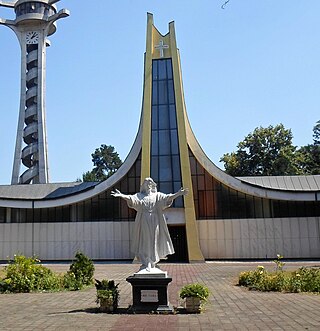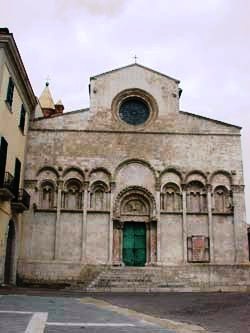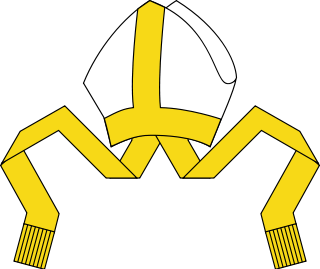
Otranto is a coastal town, port and comune in the province of Lecce, in a fertile region once famous for its breed of horses. It is one of I Borghi più belli d'Italia.

The Diocese of Banja Luka is a Latin Church diocese of the Catholic Church in western Bosnia. The diocese is centred in the city of Banja Luka, Republika Srpska, Bosnia and Herzegovina.

The Diocese of Mondoñedo-Ferrol is a Latin diocese of the Catholic Church in Spain. It is the northernmost of the four suffragan dioceses in the ecclesiastical province of the Metropolitan Archdiocese of Santiago de Compostela, which covers Galicia in the northwest of Spain. The area had previously been home to Britonia, a settlement founded by expatriate Britons in the wake of the Anglo-Saxon invasion of Britain. Britonia was represented by the diocese referred to as Britonensis ecclesia in sources from the 6th and 7th centuries.
The Diocese of Bagnoregio is a former Catholic territory, located in the modern Province of Viterbo in the Italian region of Lazio, located about 90 kilometres (56 mi) northwest of Rome. Prior to the creation of the Kingdom of Italy, it belonged to the Papal States, and was located in the region of Umbria. It had been given to the Papal States by the Emperor Louis I in 822. In terms of religious administration, it was directly dependent upon the Holy See (Papacy). The pope appointed an Apostolic Administrator for the diocese of Bagnoregio on 8 June 1970, and the bishop was not replaced when he died in 1971. The diocese was suppressed on 30 September 1986 by Pope John Paul II.

The Archdiocese of Burgos is Latin Metropolitan sees of the Catholic Church in Spain.

The Archdiocese of Bari-Bitonto is Metropolitan Latin archdiocese of the Catholic Church in the administrative Bari province, Puglia (Apulia) region, southeastern Italy, created in 1986, when the historical diocese of Bitonto was subsumed in the Archdiocese of Bari.

The Diocese of Conversano-Monopoli is a Latin diocese of the Catholic Church in Apulia. It has existed since 1986, when the diocese of Monopoli was united with the historic diocese of Conversano. The diocese is a suffragan of the Archdiocese of Bari-Bitonto.

The Diocese of Termoli-Larino is a Latin Church diocese of the Catholic Church situated in the province of Campobasso, region of Molise. The commune of Termoli is an important regional seaport. The diocese has existed in its current configuration since 1986, when the diocese of Larino was suppressed and added to its territory. It is a suffragan of the archdiocese of Campobasso-Boiano.

Richard John Sklba was an American prelate of the Catholic Church who served as an auxiliary bishop of the Archdiocese of Milwaukee from 1979 to 2010.
The Roman Catholic Diocese of Castro del Lazio was a residential bishopric from 600 to 1649 and is now a Latin Catholic titular see under the shortened name Castro.
The Diocese of Castro di Puglia was a Roman Catholic diocese located in the town of Castro of Lecce in the Apulia region of south-eastern Italy. In 1818, it was suppressed to the Archdiocese of Otranto. In 1968, it was restored as the titular see of Castro and then in 1976, as the titular see of Castro di Puglia.
The Roman Catholic Diocese of Alessano was a Roman Catholic diocese in Italy, located in the city of Alessano, in the province of Lecce, part of Apulia region of south-east Italy. On 28 June 1818, it was suppressed to the Diocese of Ugento.
The Diocese of Lesina was a Roman Catholic diocese located in the town of Lesina on the northern side of Monte Gargano in the province of Foggia, in the Apulia region of southeast Italy. Erected in the 13th century, it was suppressed in 1567 to the Diocese of Larino. It was restored as a titular see in 1968.
The Diocese of Bitetto was a Roman Catholic diocese in Italy, located in the town of Bitetto in the province of Bari, Apulia, Italy. In 1818, it was suppressed to the Diocese of Termoli.
The Diocese of Giovinazzo e Terlizzi was a Roman Catholic diocese in Italy, located in the city of Giovinazzo, in the Metropolitan City of Bari, Apulia. In 1836, it was suppressed to the Diocese of Molfetta–Giovinazzo–Terlizzi.
The Diocese of Vulturara e Montecorvino was a Roman Catholic diocese located in the city of Volturara Appula in the province of Foggia in the Apulia region of southeast Italy. The bishopric, which already existed in the 10th century, was united with that of Diocese of Montecorvino in 1433. Giuseppe Cappelletti gives detailed information about most of its bishops. In 1818, as part of a reorganization of the dioceses within the Kingdom of the Two Sicilies, the diocese ceased to exist as a residential see and its territory became part of the diocese of Lucera. It is now included in the Catholic Church's list of titular sees.

The Diocese of Mottola or Diocese of Motula was a Roman Catholic diocese located in the town of Mottola in the province of Taranto in the region of Apulia in southeast Italy. In 1818, it was suppressed to the Diocese of Castellaneta.
Lorenzo Celsi was a Roman Catholic prelate who served as Bishop of Castro del Lazio (1591–1603).
Bernardino de Leis, C.R.L. was a Roman Catholic prelate who served as Bishop of Cagli (1504–1506), Bishop of Lavello (1504), Bishop of Castro di Puglia (1504), and Bishop of Ischia (1501–1504).

Castra Severiana was an ancient Roman-era town of the Roman province of Mauretania Caesariensis, in North Africa during late antiquity.
















